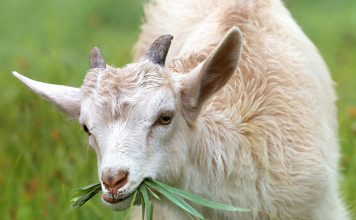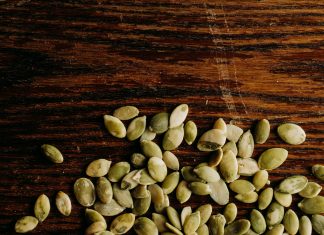 |
|
| Issue #122 • March/April, 2010 |
Humans are omnivores, which means we can eat just about anything nature has to offer. In fact, research has shown we need to eat a wide variety of foods to maintain good health. Ironically, we are also very selective about what we consider to be acceptable food. A close look at almost any particular region of the world will reveal that a mere handful of the plants and animals available there form the core of the local cuisine.
Despite this, for most of history, humans have had little trouble answering the question of what to eat without expert advice. Unfortunately, over the past several decades we have lost some of the ability to make healthful and satisfying food choices. As a result, in many parts of the world, including this country, the answer to this ever-present question: “What should I eat to make me happy and healthy,” has become more difficult to answer.
Here in the United States we seem to worry more about the health consequences of food than people in other countries do. Despite this, we suffer from what seems to be an epidemic of diet-related health problems. This includes four of the top ten causes of death related to diet: coronary heart disease, diabetes, stroke, and cancer.
Since the 1950s, university scientists and health care professionals have been conducting studies in an effort to determine the health consequences and benefits of our food choices. Recently, many of these studies have revealed that the chronic diseases mentioned above are closely linked to the industrialization of our food supply: a sharp increase in highly processed foods including refined grains and an over-reliance on chemicals to raise plants and animals. Also the diversity of our diet has been reduced to a handful of staple crops: wheat, rice, corn, and soy. In other words, we are eating a lot more processed seeds and not enough leafy and other types of plants.
A close look at the American diet reveals overconsumption of processed foods, meats, added fats, and sugar. Unfortunately, the minor elements in this diet are fruits, vegetables, and whole grains. As omnivores we require between 50 and 100 chemical compounds and other elements from our diet to stay in good health. Most nutritionists and creditable food scientists believe that we can’t get everything that we need from the diet Americans now eat.
We live in a country that on any given day produces about 3900 calories for every man, woman, and child. This number reflects what is produced in this country, minus exports and plus imports. This does not necessarily mean we each eat 3900 calories on a daily basis, but it represents a substantial excess which can be one reason that obesity is a growing problem among Americans.
In 1995 the noted cardiologist, Ancel Keys, who died at the age of 100 in 2004, wrote “Do not get fat; if you are fat, reduce. Favor fresh vegetables and fruits. Avoid the heavy use of salt and refined sugar.” The message to eat less, exercise, and eat more fresh fruits, vegetables, and whole grains seems to be a message that is easy to understand. But many of us, me included, seem to have a lot of trouble putting it into practice.
For the last 20 years I have understood the health benefits of eating vegetarian, but have not been willing to give up animal protein. However, much soul-searching and a lot of research has helped me find what I believe is a healthful solution to this dilemma. In spite of the fact that researchers have found that vegetarians have a definite health advantage over those who include meat in their diet, they also find only slight health differences between health-conscious omnivores and dedicated vegetarians. This means that your health and longevity can benefit from maintaining a healthful balance between the consumption of vegetables, whole grains, beans, and animal protein. Many nutrition experts believe that we can achieve this balance by limiting our daily consumption of meat, fish, and poultry to 20 percent of our daily calories. The remaining 80 percent should come from fruits, vegetables, and whole grains.
In my house, like many others, lunch and dinner preferences often center on comfort foods like macaroni and cheese, hamburgers, pizza, and other fat and meat-rich foods. For several years now I have been trying to find suitable vegetable-based alternatives to foods such as these. Since I am not a vegetarian and, at this time, have no intention of becoming one, I decided that the best way to increase the amount of fruits, vegetables, and whole grains in my family’s diet was to make them more attractive.
My first and most successful effort to date has been developing a variety of homemade whole grain bread recipes. These have proven to be so well accepted that commercial white bread is no longer part of our diet. But not all of these breads my family now eats are 100 percent whole grain. While developing and testing these bread recipes I discovered that acceptance or ambivalence toward any of these alternative foods usually depends on four critical elements: sight, aroma, taste, and texture. Some whole grain breads are very dense, a quality that lessens their appeal. I solved this problem by adding a measured amount of unbleached white flour.
Likewise, I discovered that serving vegetables that are simply boiled or steamed had, despite being both healthful and full of flavor, limited appeal to my family.
But there are ways to make these foods more attractive, and professional chefs who recognized the potential popularity of vegetable-based diets have opened successful restaurants in many parts of this country offering just this type of diet. They achieve success by carefully choosing high-quality foods and preparing them using well-developed preparation techniques along with flavorful spices and seasonings from around the world.
Years ago I was taught that most of our preferences or aversions to various foods are learned; that is, each of us discovers by experience what constitutes acceptable food. And, as I said, I was also taught that the four key elements in the preparation often determine what will be accepted and what will not. Success with all recipes developed in my kitchen are based on these four aforementioned elements.
1. Sight. Any food that comes to the table must look appetizing. If it doesn’t, mealtime is usually very short and most of what is on the table remains there.
2. Aroma. The nose shares an airway with the mouth. That’s why when young boys laugh at the dinner table, milk comes out their noses. As a result we most often smell and taste our food simultaneously. The 18th century French gastronome, Brillat-Savarin, outlined this in a very colorful way: “Smell and taste form a single sense, of which the mouth is the laboratory and the nose is the chimney.” His message being the former serves for the tasting of foods, and the latter is for the savoring of their gases.
The aroma of any food can be detected long before it comes to the table. When I find folks migrating to my kitchen while I am preparing a meal and they’re asking, “What smells so good?” I know that I am on the right track.
3. Taste. All flavors must be balanced to the tastes of those at the table. When I experiment, my family is my Recipe Review Committee. When they start rolling their eyes and picking at the food on their plates, I know the recipe is a dud.
4. Texture. The “I like this” or “Is there anything else to eat” response is often determined by how a particular food feels in the mouth. I find this to be a problem when I am serving all-vegetable versions of foods that are traditionally meat-based. Without the meat, the food just doesn’t “feel” right.
Some cooks attempt to get around this by adding one of the high-protein, soy-based products like textured vegetable protein. But I have found that because every vegetable has a unique look, taste, aroma, and texture, I can prepare them in ways that allow their individual qualities to shine without meat or the meat substitutes being necessary.
My second recipe here demonstrates that even a dish like chili that usually has meat as a base can be prepared without it and still satisfy all the culinary senses.
However, if you prepare a recipe right, you can still add seafood, meat, or meat substitutes to many of them by preparing those items separately and adding them to the vegetable dish as a separate ingredient and as a final step, before service. This is particularly good when you are serving a table that has both vegetarians and non-vegetarians.
All of these recipes reflect my point of view and personal taste. However, they can be adjusted and changed to reflect the tastes of others. For example, in the first recipe I recommend linguini for the pasta and grated Parmesan cheese. You may prefer another type of pasta or cheese. Or, instead of cilantro, you could substitute equal amounts of arugula and fresh parsley. After sampling these recipes I suggest you experiment with the basic techniques I present here. Try your own variations and substitutions. You will quickly discover you can prepare a wide variety of vegetable dishes that will be both attractive, full of flavor, and fun to prepare.
Recipes
|
Whole wheat pasta with chili pepper and cilantro pesto
This is one of my favorite recipes when I am short of time and need a quick, healthful, and satisfying meal. I serve this with a simple salad and hot crusty bread. Any leftovers can be successfully reheated in a microwave oven. (My choice of fresh jalapeños in this and any other of my recipes simply reflects my own taste choices of chili peppers. Feel free to substitute your favorite fresh chili in any of these recipes.)
Ingredients:
12 oz. whole wheat blend linguini (or other pasta)
water and salt to cook the pasta
½ cup walnuts, pine nuts, pecans, or slivered almonds, toasted
3 oz. freshly grated Parmesan or Romano cheese
2 cups fresh cilantro, minced
¼ cup extra virgin olive oil
1 to 3 fresh jalapeño peppers, seeded and minced
2 cloves fresh garlic, minced
½ tsp. table salt
Method:
1. Bring four quarts of water in a large pot to a boil and add one teaspoon of table salt.
2. Toast the nuts in a small dry frying pan and set aside until cool.
3. Combine the nuts and the remaining ingredients (except pasta) in a food processor or blender and process until well blended.
4. Add the pasta to the boiling water and cook until al dente. Drain the pasta reserving ½ cup of pasta water and return the pasta to the pot.
5. Add the pesto to the pasta and toss until the pasta is well coated. Adjust the consistency of the sauce with the reserved pasta water.
6. Serve in individual bowls, passing additional cheese at the table. You can also put additional toasted nuts on top of each serving.
|
Tex-Mex chili with lentils
Over the years I have prepared and served chili with every type of meat available in the supermarket or butcher shop. A slow-cooked chili made with high-quality cuts of beef, pork, lamb, poultry, or venison will always be part of the meal plan in my house. However, I am dedicated to reducing the amount of meat consumed by my family and me, so creating a meatless chili was not a option; it was a must.
In my opinion this Tex-Mex chili is as good as it gets. Using French lentils is essential to creating the proper texture in this recipe. Also, using a balanced mixture of chili seasonings instead of chili powder will give you more flexibility when preparing this dish. You can adjust the quantity of any of these seasonings to suit your own taste. Depending on who will be eating when I serve this meal, I adjust the number of jalapeño peppers from zero to three.
Ingredients for the spice mixture:
2 dried Ancho peppers, seeds, stems, and veins removed and lightly toasted in a dry skillet
2 tsp. ground cumin
1 tsp. ground coriander seed
½ tsp. crumbled dried sage
1 tsp. dried oregano
½ tsp. ground cloves
2 tsp. sweet paprika
Main ingredients:
3 Tbsp. extra virgin olive oil
1 lb. peeled and seeded butternut squash, diced ¾-inch
2 medium onions, diced
1 large green pepper, diced
4 cloves fresh garlic, minced
1 to 3 jalapeño peppers, seeded and minced
8 oz. American-style lager beer (Budweiser works well)
4 cups low-sodium chicken or
vegetable broth
1 14-oz. can diced tomatoes, drained
3 Tbsp. low-sodium soy sauce
1 cup French lentils
¼ cup instant tapioca, ground to a powder in a spice mill or coffee grinder
1 15-ounce can kidney beans, drained and rinsed
¼ cup fresh cilantro, minced
Method:
1. Prepare the spices, combine them in a small bowl, and set them aside.
2. Add one tablespoon of oil to a heavy-bottom Dutch oven set over medium-high heat. When the oil begins to shimmer, add the squash in a single layer and cook until it begins to caramelize, about four minutes. Remove the squash from the pan and set it aside.
3. Add the remaining two tablespoons of oil to the empty pot over medium-high heat. When the oil starts to shimmer, add the onions and green pepper. Cook until the vegetables begin to soften, and add the spice mixture, garlic, and jalapeño pepper. Continue to cook this mixture, stirring frequently until fragrant, about 30 seconds.
4. Add the beer, broth, tomatoes, and soy sauce. Bring the mixture to a slow boil and add the lentils and instant tapioca while gently stirring to incorporate. Bring the chili to a slow simmer, and cook until the lentils are tender, about 45 to 50 minutes.
5. Add the cooked squash and the beans to the pot. Gently stir until well incorporated.
6. Serve in individual bowls, passing the chopped cilantro at the table.
|
Vegetable curry
This is another of my favorite multipurpose recipes. I list it as vegetable dish because most of its variations are based on a variety of vegetables far too numerous to mention here. I have made this stew with broccoli, fennel bulb, celery root, summer and zucchini squash, carrots, and a variety of hearty greens like kale and collards. Tradition calls for this classic dish from India to be served with white or brown rice. I have often broken this tradition by serving it with a variety of pastas and couscous. Once you master the basic recipe, the curries you can make are limited only by your imagination and individual willingness to experiment.
In this version I have included shrimp; however, as long as you keep the quantities in line you can add small amounts of lean beef, lamb, pork, or poultry instead of shrimp to the finished recipe.
Because this curry has an abundance of bold flavors in the sauce, it is not necessary to do anything fancy or complicated with the meats or seafood. Simply prepare them as you would when making a stir fry. In this recipe I use medium shrimp, added just before the curry is served. I also use snow peas because I like them. You can substitute frozen peas or cut green beans if you like.
Ingredients:
2 Tbsp. high-quality but mild curry powder
2½ tsp. garam masala
¼ tsp. red pepper flakes
¼ tsp. fresh ground black pepper
4 Tbsp. extra virgin olive oil
2 medium yellow onions, diced fine
8 oz. red potatoes, washed and diced ½-inch
4 oz. sweet potato, peeled and diced ½-inch
4 fresh garlic cloves, minced
1 jalapeño pepper (more or less, to taste), seeded and minced
1 Tbsp. fresh ginger, minced
1 Tbsp. tomato paste
½ head medium cauliflower, trimmed, cored and cut into 1-inch florets
1 14-ounce can diced tomatoes, lightly pulsed in a food processor
1 cup low-sodium vegetable broth
½ tsp. table salt
¼ cup dry vermouth
1 15-oz. can chickpeas, drained and rinsed
1½ cups frozen sugar snap peas, thawed
¼ cup whole milk, plain yogurt, or coconut milk
Optional ingredients (you can use any one of the following):
1 lb. medium shrimp, peeled and deveined
1 lb. boneless skinless chicken thighs, cut into one-inch pieces
12 oz. boneless country-style pork spare ribs, cut into one-inch pieces
1 lb. boneless leg of lamb, cut into one-inch pieces
You can incorporate any of these optional ingredients as a final ingredient before bringing this curry to the table, or you can separate out the vegetarian amount first. Since the vegetables, broth, and spices contribute most of the flavor to these recipes, meat, seafood, or poultry can be treated as textural enhancements.
Shrimp can be simply sprinkled with a little salt and pepper, then sautéed in batches in a small amount of oil over medium-high heat until they start to turn pink.
If you decide to work chicken, pork, or lamb into this recipe, place the meat of choice into a suitable-size bowl with ½ tablespoon of curry powder and toss until the meat is evenly coated. Heat one tablespoon of vegetable oil in a Dutch oven over medium-high heat until it begins to shimmer. Add the chicken, pork, or lamb and sauté, stirring occasionally, until it starts to change color. Add one cup of chicken or vegetable stock, cover the pot, reduce the heat to medium, and continue cooking until the meat is tender. This will take 5 to 10 minutes for chicken and pork and about 35 minutes for lamb.
Remove the meat and any remaining liquid from the pot and set it aside. Wash the pot and proceed with the rest of the recipe.
Method for the curry:
1. Toast the curry powder and garam masala in a small dry skillet over medium heat. Stir the spices constantly until they start to darken slightly and become fragrant. This will take about one or two minutes. Remove them from the heat and add the pepper flakes and black pepper.
2. Heat three tablespoons of oil in a large Dutch oven over medium-high heat until shimmering. Do not allow the oil to start smoking. If it does, discard it and start over. Add the onions and potatoes. Stir this combination occasionally until the onions start to caramelize and the potatoes begin to brown.
3. Reduce the heat to medium. Using a wooden spoon, clear a small space in the center of the pot and add the remaining tablespoon of oil, garlic, jalapeño pepper, ginger, and tomato paste. Stir constantly until the mixture becomes fragrant, about 30 seconds.
4. Add the toasted spices and cook, stirring constantly, for a minute longer.
5. Add the cauliflower and cook, stirring constantly, until the spice mixture coats the florets.
6. Add the tomatoes, vegetable broth, chickpeas, vermouth, and ½ teaspoon of table salt. Increase the heat to medium-high to bring the mixture to a boil. Gently scrape the bottom of the pot to loosen any browned bits. Reduce the heat to medium-low, cover the pot, and simmer the curry, stirring occasionally, until the vegetables are tender. This should take about 15 minutes.
7. Finally, gently fold in the snap peas, yogurt, and shrimp or meat.
8. Adjust the seasoning with salt and fresh ground black pepper.
9. Serve over rice.
Pasta and bean soup
This soup was my first successful attempt to serve a meal to a group that included a vegetarian (my son Michael), an almost vegetarian (my daughter Sarah), and three omnivores (my wife Tricia, my son Jason, and me). My challenge was to produce a soup without meat for Michael and control the amount of meat to the satisfaction of everyone else at the table.
This recipe is based on a classic Italian recipe for pasta and bean soup, but the addition of extra vegetables has transformed it into a hybrid minestrone, another great soup. For meat I use a small amount of sweet Italian sausage as more of a condiment than a major ingredient. It adds the flavor and texture that meat eaters expect from a soup like this.
I served this soup with a fresh baked whole wheat pizza bianca and a marinated tomato salad. The meal was a big hit.
Ingredients:
8 oz. sweet Italian sausage
2 15½-oz. cans cannellini beans, drained and rinsed
4 cups low-sodium vegetable broth (Swanson’s is best)
3 cups water
1 28-oz. can diced tomatoes,
undrained
2 Tbsp. extra-virgin olive oil
2 medium yellow onions, diced
2 medium carrots, peeled and diced
2 celery stalks, washed and diced
1 tsp. dried thyme
¼ tsp. red pepper flakes
4 medium garlic cloves, minced
1 sprig of fresh rosemary
½ head Savoy cabbage, cored, outer leaves removed, and cut into ½-inch pieces
1¼ cup ditalini, uncooked
1 cup grated Romano cheese
salt and pepper to taste
Method:
1. Remove the sausage from the casings (discard the casings) and cook in a heavy-bottom skillet over medium-high heat, breaking up the pieces with a wooden spoon until fully cooked. Transfer the cooked sausage to a clean paper towel and set aside. This should take about five minutes.
2. Puree half the beans with two cups of broth in a food processor. Combine this pureed mixture with the remaining two cups of broth, water, and tomatoes and set it aside.
3. Heat the olive oil in a heavy-bottom Dutch oven with the burner set on medium-high until shimmering. Add the onions, carrots, and celery and cook until softened. This should take about 10 minutes.
4. Add the thyme, red pepper flakes, fresh garlic, and fresh rosemary sprig and cook, stirring constantly, for about 30 seconds.
5. Combine the pureed bean mixture and the diced Savoy cabbage with the sautéed vegetables and bring to a gentle boil. Reduce the heat and simmer for 10 minutes.
6. Add the ditalini and the remaining beans and bring the soup back to a boil. Reduce the heat to a gentle simmer and cook for about 15 minutes, or until the vegetables and pasta are tender.
7. Gently stir in half the Romano cheese.
8. If there will be non-meat-eaters at the table, transfer enough soup for them to another pot and add the sausage to the remaining soup.
9. Simmer both soups for another five minutes. Adjust the seasoning with salt and pepper and serve with the remaining Romano cheese on the side.
|
Baked brown rice
Years ago when I decided that I was not built to walk around carrying 220 pounds of body weight, I started examining all of my favorite foods to determine what I had to eliminate from my diet or moderate the portion size thereof. White rice, of all varieties, was at the top of the list, though it’s still one of my favorite foods. Dietitians that I worked with suggested brown rice as an alternative. Brown rice retains a layer of bran over the starchy kernel. This bran layer, which is not digested, adds fiber to the dish along with some added vitamins and minerals. Compare equal portions of brown and white rice and you’ll find that brown rice has fewer calories and more nutrition.
My initial attempts to prepare brown rice were disappointing, to say the least. Most of the stove-top recipes I tried produced an end product that was inconsistent and unpredictable. Here is a classic example of good food coming to the table missing most or all of the elements that make food appealing.
Out of frustration I shared my problem with a Greek chef I was working under at the time. He suggested I abandon the stove-top method and try oven baking. He also suggested I consider adding some zip to the rice by dressing it up a little. He quickly jotted down a couple of simple recipes and told me to give them a try. I did, and I have been using his basic formula ever since.
The two recipes that follow are based on his advice. If you have ever experienced problems cooking brown rice, give these recipes a try. The health benefits of brown rice are well known. With this cooking method you can add eating enjoyment to this benefit.
Ingredients:
4 tsp. extra virgin olive oil
2 medium onions, chopped fine
2 cloves fresh garlic, minced
1½ cups long grain brown rice
1 cup low-sodium vegetable or chicken broth
2¼ cups water
Method:
1. Adjust an oven rack to the middle position and preheat the oven to 375° F.
2. Heat the oil in a Dutch oven over medium heat until shimmering. Add the onions and cook, stirring occasionally until browned. Then add the minced garlic and cook while stirring for about 30 seconds.
3. Add the rice and cook stirring occasionally until the grains turn translucent around the edges.
4. Add the broth and water and bring the mixture to a boil. Stir the rice so that it does not stick to the bottom of the pot. If you are using a 10-inch Dutch oven or smaller, cover the rice, place it in the oven, and cook until the rice is tender. This should take about 45 to 50 minutes. If you are using a larger pot, transfer the rice mixture to a suitable-size casserole and cover tightly before placing it in the oven. (Larger Dutch ovens will cook the rice too fast and create too many problems.)
5. When the rice is fully cooked, remove it from the oven. Gently fluff the rice with a fork, and set it aside for about five minutes before serving
|
Brown rice with kale
Archie, the Greek chef who gave me this concept for cooking brown rice, also prepared an expanded version of his brown rice dish. He called it spanakorizo. He made it with fresh spinach and served it as a side dish with grilled lamb chops. I have made some minor changes to this formula in order to incorporate one of my favorite greens, kale. Kale is one of the most nutritious and versatile green plants that I am aware of. It was one of the most popular green vegetables in Europe for many decades. It is by far one of the heartiest and most nutritious plants grown today. The flavor and texture of both fresh and frozen kale make it a perfect complement to many of my favorite recipes. I use kale in this recipe because, unlike spinach, it can hold up to extended cooking times without becoming mushy or developing off-flavors
As an added flavor enhancement, Archie would sprinkle a little feta cheese on his spinach version of this dish before serving.
Since kale has a more robust flavor than spinach, I prefer Gorgonzola, Stilton, or another blue cheese. However, if these cheeses are not to your liking, feta still works well with this recipe.
Once again, if you think your Dutch oven is too large for this rice, you can transfer it to a more suitable-size casserole or oven-proof heavy-bottom pot before placing it in the oven
Ingredients:
1 Tbsp. extra virgin olive oil
2 yellow onions, diced
1 lb. fresh kale, washed, center rib removed, and the leaves chopped into one-inch pieces
4 cloves fresh garlic, minced
2 Tbsp. fresh dill or ½ tsp. dried
½ tsp. table salt
¼ tsp. red pepper flakes
1½ cups long grain brown rice
1 15-oz. can diced tomatoes, drained
¼ cup dry vermouth
3 cups low-sodium vegetable broth
½ cup crumbled blue or feta cheese
2 Tbsp. coarsely chopped walnuts, toasted
1 Tbsp. finely chopped fresh parsley
Method:
1. Preheat the oven to 375° F.
2. Heat the olive oil in a Dutch oven over medium-high heat until it starts to ripple. Add the onion and cook, stirring frequently, until the onion begins to brown.
3. Add half the fresh, chopped kale and cook until the kale begins to wilt, then add the remaining kale, garlic, dill, salt, and red pepper flakes and stir until the kale wilts, about one minute.
4. Add the rice and stir until the rice is completely incorporated.
5. Add the tomatoes, vermouth, and vegetable broth and gently stir until well incorporated.
6. Increase the heat to high until the pot comes to a slow boil, stirring with a wooden spoon to prevent sticking. Then cover the pot and place it in the oven and cook for about 45 to 55 minutes. Check the progress of the casserole at 40 minutes to avoid overcooking.
7. When done, remove the rice from the oven, fluff it with a fork, and evenly distribute the cheese, walnuts, and parsley on top. Serve immediately.
|
Fusion pasta
Pasta is a healthful food with endless possibilities for folks struggling to improve their daily diet while avoiding the boredom that is often associated with this noble effort.
My family will eat pasta in almost any form. Pasta can be prepared in innumerable ways. In fact, it is possible to serve it every day of the year and never repeat yourself. Since the same can be said for vegetables it is not difficult to prepare a wide variety of pasta and vegetable combinations that are both appealing and nutritious.
I call this dish “fusion pasta” because it contains ingredients from different cuisines: Italy, Mexico, India, the American Southwest, and New England. I serve this dish with a salad and hot Italian or French bread and no one at the table has ever asked, “Is there any meat in this recipe Dad?”
Ingredients:
2 bulbs fresh garlic, papery skins and the top ¼ of the stem end removed
5 Tbsp. plus 1 tsp. extra virgin olive oil, divided
2 cups butternut squash, diced into 1½-inch cubes
1 cup fresh carrots, peeled and diced into 1-inch pieces
1 cup rutabaga, peeled and diced into 1-inch pieces
salt and pepper to taste
1 chipotle pepper in adobo sauce, minced
¼ cup raw pepitas (small, unsalted pumpkin seeds)
½ cup pecans, coarsely chopped
½ cup vegetable broth
1 tsp. chili powder or ancho powder
1/3 cup light coconut milk
¼ cup shredded, smoked mozzarella cheese or gruyere cheese
4 qts. water
1 Tbsp. salt
1 lb. penne, rigatoni, or other tubular pasta
Notes on ingredients:
Many supermarkets sell coconut cream alongside coconut milk. Do not confuse the two. Coconut cream is sweetened and is not suitable for a recipe like this one.
Pepitas are small pumpkin seeds. They are sweeter and more tender than large pumpkin seeds. Most supermarkets sell both, but you will most often be able to tell the difference between the two, because if you’re buying pepitas the name will be on the package.
Ancho powder is simply a ground form of dried ancho chilis. This is a popular ingredient in many authentic Mexican recipes and original Southwestern chili recipes.
Method:
1. Preheat the oven to 450° F.
2. Cut a 12-inch piece of aluminum foil and spread it on the counter. Place the garlic bulbs, cut side up, in the middle of the foil and drizzle ½ teaspoon of olive oil on each bulb. Fold the foil loosely around the garlic to form a packet.
3. In a large bowl, mix two tablespoons of olive oil, the squash, carrots, and rutabaga. Lightly season the vegetables with salt and fresh ground pepper. Place the vegetables on a rimmed baking sheet.
4. Place the packet with the garlic and the baking sheet with the vegetables in the oven and roast until the garlic and vegetables are tender, about 40 minutes.
5. When ready, remove the garlic from the oven, open the packet and set aside to cool. Transfer the vegetables to a suitable-size bowl and mash with a fork. It is not necessary to mash the vegetables until smooth. I prefer to leave them somewhat chunky.
6. When cool, squeeze the garlic from the skins into a small bowl. Using a fork mash the garlic into a paste. Mix the garlic pulp with the chipotle pepper and set aside.
7. Place a small skillet over medium-high heat and heat a tablespoon of olive oil until it shimmers in the pan. Do not allow it to smoke. Add the pepitas to the hot oil and shake them in the pan until they are lightly browned. Transfer the toasted pepitas to a plate and set aside. Place the pan back on the heat and add the pecans. No additional oil is necessary. Toast the pecans over medium heat until lightly browned and add them to the pepitas. Mix the pepitas and pecans with the chili or ancho powder and set aside.
8. Before you start the final preparation of the sauce, place a large pot with four quarts of water and one tablespoon of salt on a burner to boil.
9. Place a 12-inch nonstick skillet over medium heat with the remaining olive oil. While the oil is heating, combine the mashed vegetables with the broth and garlic paste and mix until combined. Place this mixture in the skillet and heat evenly. Add the coconut milk and mix to combine. Reduce the heat to medium-low and slowly simmer the sauce until it is heated through.
10. While the sauce is cooking, add the pasta to the boiling water and cook until al dente. Drain the pasta, reserving one cup of the water. Return the drained pasta to the pot.
11. Pour the sauce over the pasta and gently mix with a wooden spoon. If the sauce seems too thick, adjust the consistency with the reserved pasta water.
12. Place the pasta in a serving dish and sprinkle with the smoked mozzarella or gruyere cheese.
13. Serve immediately, passing the nut and seed mixture around the table to be used as a topping.
Roasted winter vegetables
Roasting intensifies the flavor of any vegetable. When applied to root vegetables, it also adds a sweet, caramelized flavor that mellows sometimes strong-tasting root vegetables like rutabaga.
Ingredients:
1 lb. small red potatoes, quartered
1 lb. carrots, peeled and cut into 2-inch pieces
3 parsnips, peeled and cut into 2-inch pieces
3 small red onions, peeled, root end left in tact and quartered
1 lb. rutabaga, peeled and diced into 1-inch pieces
4 cloves fresh garlic, peeled and left whole
¼ cup extra virgin olive oil
1 Tbsp. fresh rosemary, minced
2 tsp. table salt
¼ tsp. red pepper flakes
2 tsp. balsamic vinegar
Method:
1. Preheat the oven to 450° F.
2. In a large bowl, toss the vegetables with the other ingredients. Spread the vegetables in a single layer on large baking sheet.
3. Roast the vegetables, gently turning with a wooden spoon every 15 minutes until tender and slightly caramelized, about 45 minutes. This makes a wonderful side dish with any meat, fish, or poultry main entrée.
|
Stir-fried vegetables with garlic and oyster sauce
For the past several years I have been preparing a variety of stir-fried meals for my family using a wide variety of meats, seafood, and vegetables. Stir-fry is hard to beat when it comes to fast and easy preparation. Sliced vegetables and meat are cooked over high heat which allows for fast cooking and prevents the meat or vegetables from steaming rather than frying. They are then tossed with a savory sauce and served. If you follow a few basic rules stir-frying at home, you can avoid all of the common problems associated with this basic and simple Oriental method of cooking.
The wok is the pan traditionally used to prepare this dish. Chances are you don’t own a gas-fired pit-type stove top that is designed to deliver maximum heat to the entire curved bottom surface of a wok. If this is true, you can achieve excellent results using a heavy-bottom nonstick 12-inch skillet or Dutch oven. The wide, flat bottoms of these pans are best suited for cooking on a standard flat electric or gas burner.
Success with this recipe, and all stir-fries, requires accurate timing. Before you begin cooking, memorize as much of the recipe as possible. Have all of your tools, vegetables, meats, seasonings, and sauce ingredients prepared and arranged in the order in which you intend to use them. This will allow you to concentrate on cooking rather than reading or chopping ingredients.
Note for vegetarians: Regular oyster sauce contains oyster extracts. If you are a strict vegetarian, an all-vegetable version of this sauce can be found at most Oriental grocers or online. Amazon.com has several vegetarian sauces produced by Lee Kum Kee, one of the industry leaders in high-quality Oriental sauces.
|
Ingredients for the sauce:
2 Tbsp. low-sodium soy sauce
1½ Tbsp. oyster sauce
1 tsp. rice vinegar
2 tsp. toasted sesame oil
6 Tbsp. low-sodium vegetable or chicken broth
1¼ tsp. cornstarch
Main ingredients:
1 Asian eggplant, ends trimmed, cut in half lengthwise and cut crosswise into ½-inch half-moons
4 fresh carrots, peeled and cut on the bias ¼-inch thick
1 cup snow peas, strings and tough ends removed
1 small summer or zucchini squash, quartered, seeded, and cut on the bias ¼ inch thick
1 small head bok choy, core removed and greens separated from the ribs; the ribs should be cut on the bias into ¼-inch wide strips while the greens are cut into ¾-inch strips
2 Tbsp. plus 1 tsp. vegetable or peanut oil, separated
½ cup low-sodium vegetable or chicken broth
4 fresh garlic cloves, minced
2 Tbsp. fresh ginger, minced
Method:
1. If you plan to add meat or shrimp to this recipe, prepare it first as instructed in the sidebar, then set it aside and wash the pan before proceeding with the recipe.
2. Combine the sauce ingredients in a small bowl and set aside. Prepare each of the vegetables in the order listed in the recipe and set them aside in separate containers. The garlic and ginger can be combined.
3. Heat one tablespoon of oil over high heat until it just begins to smoke. Add the eggplant and cook, stirring frequently for about two minutes. Remove the eggplant from the pan and set it aside.
4. Add one teaspoon of oil to the now empty pan. Add the carrots, stirring occasionally, until they begin to brown.
5. Add ½ cup of vegetable or chicken broth and cover the pan; cook until the carrots are just tender, about two to three minutes. Uncover the pot and continue to cook until the liquid evaporates, about 30 seconds. Transfer the carrots to a plate with the eggplant.
(Note: Use this technique with all longer-cooking vegetables such as broccoli, cauliflower, asparagus, and green beans.)
6. Heat the remaining tablespoon of oil over high heat and add the snow peas, squash, and bok choy ribs. Cook, stirring constantly, for about one or two minutes, until the vegetables begin to brown. Add the bok choy greens, stirring frequently until wilted, about one minute.
7. Push the vegetables to the side of the pan and place the garlic and ginger in the center. Cook until fragrant, about 15 seconds, then stir them into the other vegetables in the pot.
8. Return all vegetables and meat or shrimp, if you are using them, to the pot along with the sauce. Continue to cook, gently stirring until the sauce is thickened and the vegetables are coated. Transfer to a serving dish and serve immediately with rice or noodles.





















